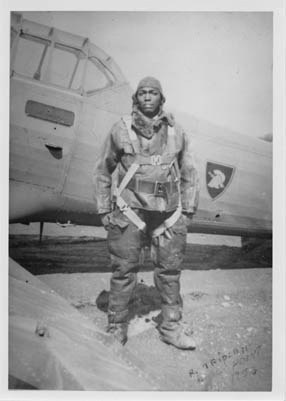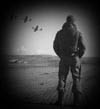Raymond W. Triplett

The name of the Triplett family has not only played a significant roll in the history of La Mott, but it has also been synonymous in the military of the United States. Although, no direct member of the Triplett family was trained at Camp William Penn, the family’s dedication to the military began with World War I. Despite the tragic loss of Norman Triplett during that conflict, members of the family have served up until today in various branches of the U.S. military.
One of those members was Raymond N. Triplett. (Army Serial number 6877285) With his enlistment on August 14, 1936, began a history that has all of the pride, determination and accomplishments of those men who were trained at Camp William Penn nearly three-quarters of a century previously.
In a document found among his effects, written by him, he states:
“Raymond N. Triplett, enlisted in the Medical detachment Station Hospital, United States Military Academy, West Point, New York, 14 August 1936.
January 1938, I was rated a medical technician and promoted to Private 1st Class. August 1938, following the accidental death of Private 1st Class Allen H. Bowman, brother-in-law of Sgt. Blake of E Troop, 10 Cavalry, I was rated a surgical technician and assigned to the late Private Bowman’s position as assistant to the surgeon of genito-urinary medicine. It was at this time that I made myself acquainted with the officers and men of the West Point Air Detachment. This resulted in numerous local and cross country flights for me in the amphibians that were stationed in the river and the railroad track, and to the north was the old Stewart Field where I flew in other types of Army aircraft.” (Editor’s Italics)
Editor Note: At the time, the flight regulations required that all flights were to be accompanied by someone as an “Observer”, Triplett flew on many of these flights in that capacity. In the process, he was unofficially taught how to fly. Many of those flights were with a pilot who lived in the Cheltenham area and Triplett was able to fly with him and visit his relatives in La Mott.
“11 February I was promoted to Sergeant. Special Order#41 Headquarters, United States Military Academy, dated 26 February 1941, transferred me to the 366th Infantry, Fort Devans, Massachusetts.”
Editor Note: 366th Infantry Regiment – Alabama in WW I and WW II it was activated at Ft. Devens, MA, a year before the outbreak of World War II, the as an all-black fighting unit with black officers, an unprecedented event in the history of the United States — prior to this time, all of the black units had been commanded by white officers.
“March 1941 I was promoted to Staff Sergeant per order of the 1st Army Surgeon. May, 1942, I was promoted to 1st Sergeant,
Following maneuvers at Camp Atterbury, Indiana, the 366th Infantry transferred to Hampton Roads, Virginia. We boarded the USS William Mitchell, destination North Africa. From 28 March to 6 April 1944, I was assistant to the troop surgeon. The regiment and I disembarked 6 April at Casablanca. We bivouacked at this location until 18 April when we boarded 40 and 8’s and started moving across the desert to the port of Orean, North Africa. There we boarded the HMS Orduna, in convoy with overhead air cover and sleeping on open deck. We sailed the Mediterranean to Napoli where we disembarked while under fire.
The regiment was assigned to the 15th Air Force, Regimental Headquarters (http://www.frankambrose.com/pages/15th.html) and I was sent to the town of Sammichele, in close proximity to the headquarters of the 464th Bomb Group (http://www.frankambrose.com/pages/465.html)
The C.O. was Col. William H. Bonner, an officer I had flown with while stationed at West Point. This chance meeting resulted in mission flights to ………” Editor Note: End of document. The subsequent pages have to date not been located.
Historic Notes:
Tuskegee Airmen
(1941-1946) The School at Tuskegee founded by Booker T. Washington (http://www.ushistory.net/toc/washington2.html) had a well-respected aeronautical engineering program. Because of the Institute’s flying program, the U.S. Military selected Tuskegee Institute as a place to train African-American pilots for the war effort. Aviators came to Tuskegee, Alabama to hone their flying skills. Their rigorous training at Moton Field and Tuskegee Army Air Field molded over 1,000 pilots into one of the most highly respected U.S. fighter groups of World War II. (Ref. National Park Service Museum Management Program)
The school at Tuskegee founded by Booker T. Washington had a well-respected aeronautical engineering program. Because of the Institute’s flight program, the U.S. military selected program. Because of the Institute’s flight program, the U.S. military selected Tuskegee Institute

http://www.wpafb.af.mil/museum/history/prewwii/ta.htm
http://nasaui.ited.uidaho.edu/nasaspark/safety/history/
Although Raymond N. Triplett did not attend any of the Army’s flight schools he nevertheless learned to fly and flew in U.S. Army military airplanes years before any formal training was offered to prospective black pilots. After the completion of his military service, Triplett continued to fly, now as a licensed pilot. He joined the Negro Airman International (http://www.blackwings.com/history.htm) and became the Chaplain to that group. N. Triplet
p://www.wpafb.af.mil/museum/history/prewwiprewwii/ter groups of World War II.
Moton Field and Tuskegee Army Air Field molded over 1,000 pilots into one of the most highly respected U.S. fighter groups of World War II.
Entrance Gates, Moton Field
1999 – National Park Serviceonal Park Service
World War II.
Wally Triplett

Wally Triplett, 92, a trailblazing former Montgomery County resident who became the first African American to start on the Penn State football team and later the first to be drafted and play in the NFL, died Thursday November 8th 2018 at his home in Detroit.
Mr. Triplett, a three-sport athlete at Cheltenham High School who was from La Mott, played tailback and linebacker at Penn State from 1945 through 1948. According to university records, his first start came on Nov. 17, 1945.